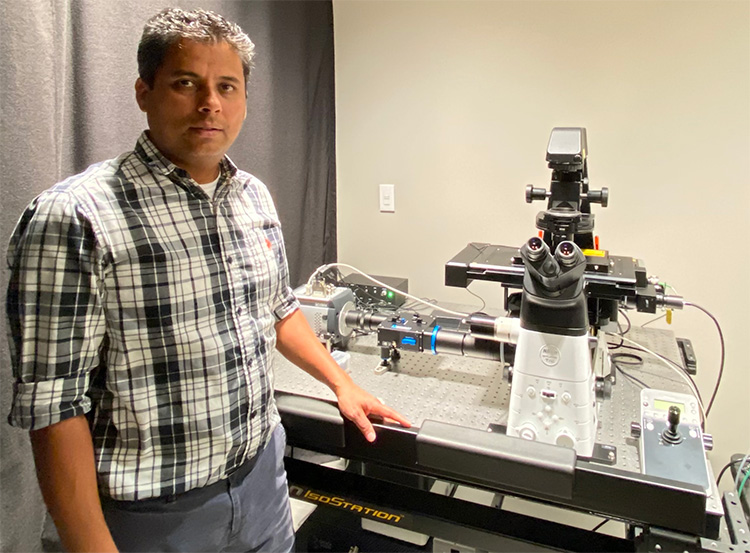Research News – 2023

Fighting Candida Virulence
Candida albicans is a fungal human pathogen that causes severe disease by infecting epithelial and immune cells. C. albicans secretes candidalysin, a virulence factor that is required for infection. Candidalysin is a peptide that perforates the lipid membrane that coats cells. This damages the integrity of human cells and initiates the infection process. However, the molecular mechanism that candidalysin uses to form pores is not known, in part due to difficulties in probing interfacial membrane processes with high resolution.
Research in the Barrera lab has started to get around this problem. Boomer Russell, a graduate student in the Barrera laboratory, is first author on a manuscript published in eLife that unravels how candidalysin works. It turns out that candidalysin uses a molecular mechanism that has never been observed. Against all expectations, candidalysin peptides get together in solution with high affinity, forming a polymer. These polymers close to form loops, which then bind to membranes and form a membrane pore.
This quite unexpected mechanism is reviewed in an article written by Russell and another graduate student in the lab, Jen Rybak in The Journal of Biological Chemistry. Understanding the candidalysin mechanism will allow for the development of drugs that block its role in fungal infection of humans.

Ethylene Priming to Grow Bigger and More Stress Tolerant Plants
Ethylene is a gaseous plant hormone that affects plant growth and stress responses. Its practical applications in horticulture, such as ripening bananas, are common knowledge. The Binder lab recently made several advances to understand ethylene signaling. In collaboration with long-time collaborator Eric Schaller at Dartmouth College, they published an article in the Proceedings of the National Academy of Sciences that combines computational and experimental approaches to understand the structural basis for the high affinity binding and signal propagation by ethylene receptors.
A second collaboration with the lab of Gyeong Mee Yoon at Purdue University published in Nature Communications expands our understanding of the spatiotemporal dynamics involved in ethylene signaling components down-stream of the receptors. Most recently, the Binder lab, in collaboration with Dan Roberts, found that transiently treating germinating seeds with ethylene causes a priming effect leading to large increases in both plant growth and stress tolerance which persist throughout the plants’ lifetime. This discovery, published in PNAS-Nexus, is particularly exciting since growth and stress tolerance usually exhibit an inverse relationship.
Lead author Eric Brenya, a postdoctoral researcher in the Binder lab, highlights the potential of this finding for horticulture and agriculture: “Given the challenges posed by global warming and diminishing arable land, these discoveries are crucial in sustaining the growing human population.”
The Binder lab is now determining the mechanisms for this priming with funding from a recently awarded NSF grant.

Dynamics of G Protein-Coupled Receptors
G protein-coupled receptors (GPCRs) carry out diverse and important functions and are the target of many therapeutic drugs. The Lamichhane lab continues unraveling the dynamics of GPCRs using single-molecule fluorescence microscopy.
Recently, they made progress to better understand how GPCRs function by characterizing the dynamics of helix 7 of the human A2A adenosine receptor. These findings, published with graduate student Shushu Wei as lead author in Structure, illustrate that there is a critical intermediate conformational state that has been missed in the currently available structures of this receptor. They also showed that the conformational dynamics of these receptors are temporally ordered, which has implications for understanding how agonists and antagonists affect these receptors and could lead to better drug design to target these receptors. They also have made progress in understanding the dynamics of the extracellular domain of the glucagon receptor, which is important in carbohydrate homeostasis.
Their findings, detailed in Journal of Biological Chemistry, provide information for the development of therapeutics for diabetes and underscores the lab’s commitment to advancing our knowledge of molecular interactions and conformational changes of these important receptors. These studies were made possible because of an R35 Maximizing Investigators’ Research Award from NIH to Lamichhane.

Nature’s Artistry: Exploring the Mesmerizing World of Plant Shapes and Forms
From towering trees with sprawling canopies to delicate vines that elegantly entwine, from the intricate geometry of fern fronds to the symmetrically layered petals of a flower, the diversity in plant shapes is truly captivating.
All above-ground organs of plants originate from the shoot apical meristem (SAM), a group of undifferentiated stem cells located between the cotyledons of an embryo and later at the apex of a plant’s stem. Even though cells are constantly growing and dividing, the size of the SAM remains unchanged throughout development due to a tight balance between cell proliferation and incorporation of cells into forming organs.
Researchers in the Shpak lab study cell-cell communications in the SAM. Recently, they uncovered that two signaling pathways are necessary to promote the differentiation of organs in the periphery of the SAM. This research, published in Development, shows that when these signaling pathways are nonfunctional, the SAM grows bigger and bigger but never can form stems, leaves, and flowers. The pathways inhibit the expression of a transcription factor that promotes stem cell identity.
More recent research from the Shpak lab published in Plant Physiology indicates that there is a complex interplay between auxin and other signaling pathways to regulate SAM. Currently, members of the lab are studying signaling that promotes the initiation of leaves and regulates the shape of flowers and the formation of ovules. This work will help us to uncover the molecular mechanisms responsible for the kaleidoscope of plant shapes and forms.